Serving 768 students in grades 8-12, Celina High School ranks in the bottom 50% of all schools in Ohio for overall test scores (math proficiency is bottom 50%, and reading proficiency is bottom 50%).
The percentage of students achieving proficiency in math is 38% (which is lower than the Ohio state average of 52%). The percentage of students achieving proficiency in reading/language arts is 55-59% (which is lower than the Ohio state average of 60%).
The student:teacher ratio of 17:1 is equal to the Ohio state level of 17:1.
Minority enrollment is 15% of the student body (majority Hispanic), which is lower than the Ohio state average of 34% (majority Black).
Quick Stats (2025)
- Grades: 8-12
- Enrollment: 768 students
- Student:Teacher Ratio: 17:1
- Minority Enrollment: 15%
- Graduation Rate: 85-89% (Btm 50% in OH)
- Overall Testing Rank: Bottom 50%
- Math Proficiency: 38% (Btm 50%)
- Reading Proficiency: 55-59% (Btm 50%)
- Science Proficiency: 70-74% (Top 50%)
- Source: National Center for Education Statistics (NCES), OH Dept. of Education
School Overview
Celina High School's student population of 768 students has declined by 11% over five school years.
The teacher population of 45 teachers has declined by 16% over five school years.
Grades Offered
Grades 8-12
Total Students
768 students
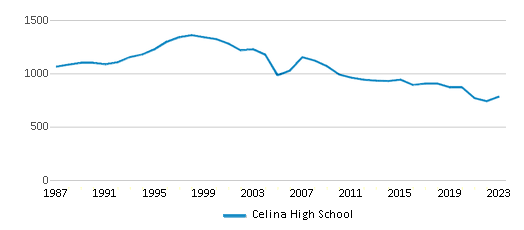
Gender %
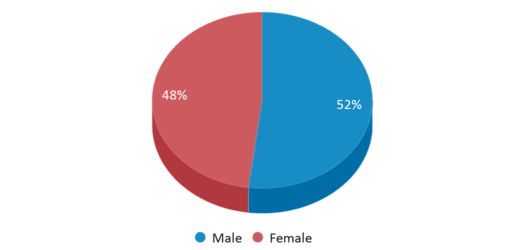
Total Classroom Teachers
45 teachers
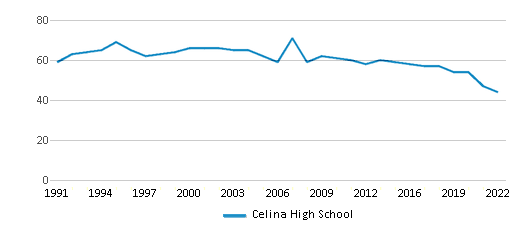
Students by Grade
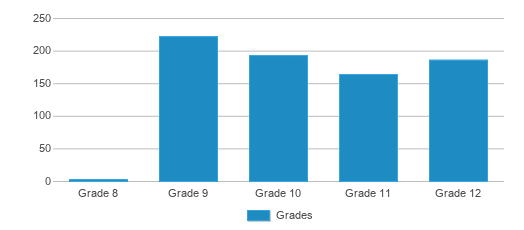
School Rankings
Celina High School ranks within the bottom 50% of all 3,241 schools in Ohio (based off of combined math and reading proficiency testing data).
The diversity score of Celina High School is 0.27, which is less than the diversity score at state average of 0.53. The school's diversity has stayed relatively flat over five school years.
Overall Testing Rank
#2027 out of 3241 schools
(Bottom 50%)
(Bottom 50%)
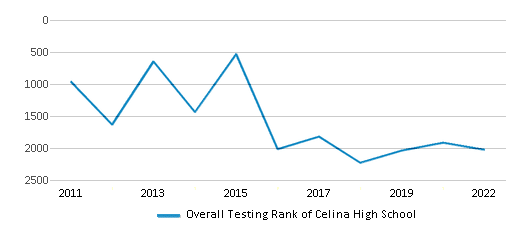
Math Test Scores (% Proficient)
38%
52%
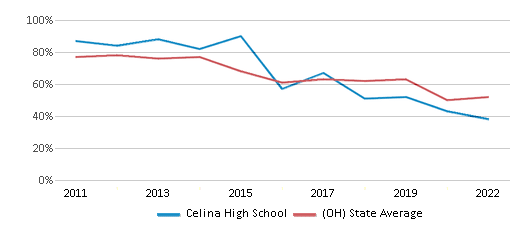
Reading/Language Arts Test Scores (% Proficient)
55-59%
60%
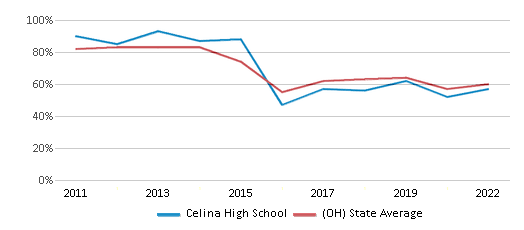
Science Test Scores (% Proficient)
70-74%
63%
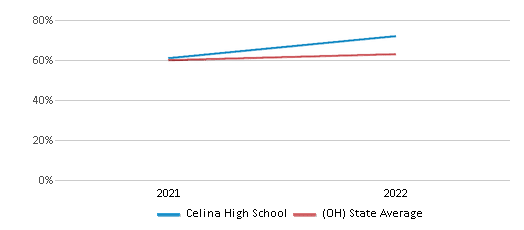
Student : Teacher Ratio
17:1
17:1
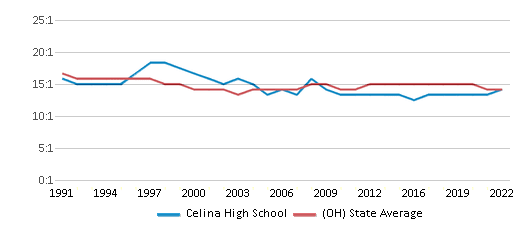
American Indian
n/a
n/a
Asian
1%
3%
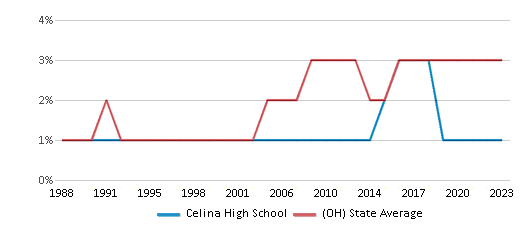
Hispanic
4%
8%
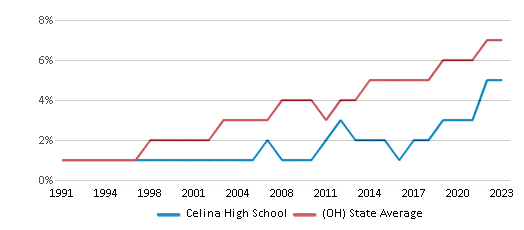
Black
1%
17%
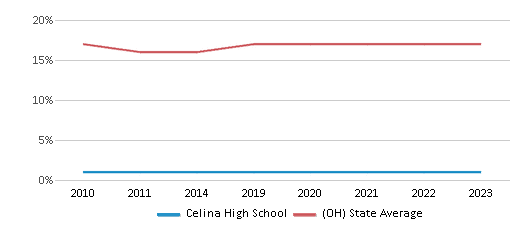
White
85%
66%
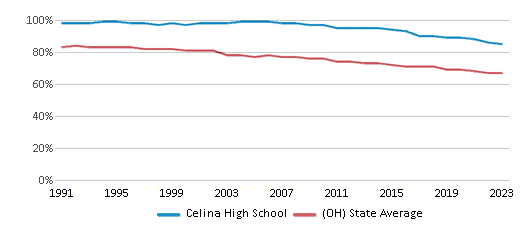
Hawaiian
6%
n/a
Two or more races
3%
6%
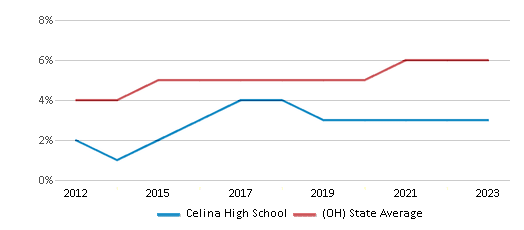
All Ethnic Groups
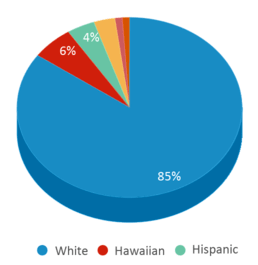
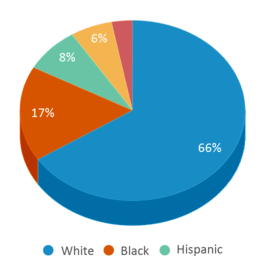
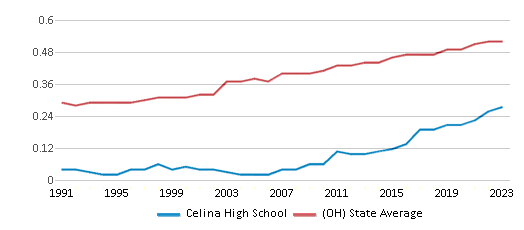
Graduation Rate
85-89%
86%
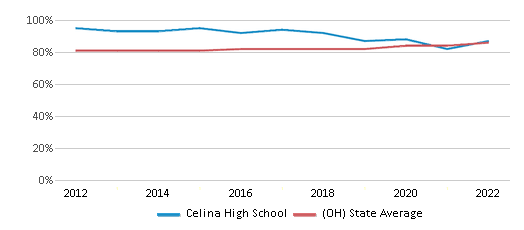
Participates in the National School Lunch Program (NSLP)
Yes
Eligible for Free Lunch
33%
42%
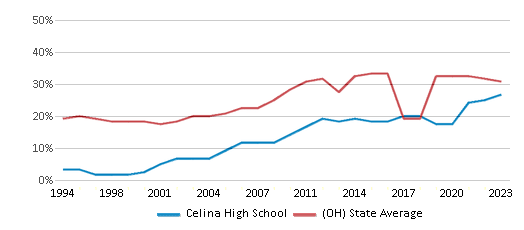
Eligible for Reduced Lunch
13%
5%
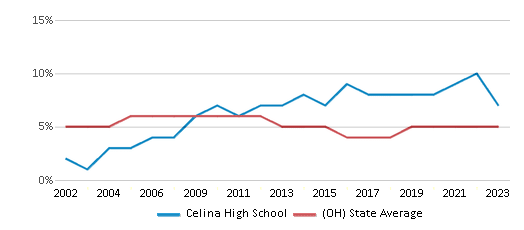
School Statewide Testing
School District Name
Source: National Center for Education Statistics (NCES), OH Dept. of Education
Profile last updated: 02/09/2025
Frequently Asked Questions
What is Celina High School's ranking?
Celina High School is ranked #2027 out of 3,241 schools, which ranks it among the bottom 50% of public schools in Ohio.
What schools are Celina High School often compared to?
Celina High Schoolis often viewed alongside schools like Coldwater High School by visitors of our site.
What percent of students have achieved state testing proficiency in math and reading?
38% of students have achieved math proficiency (compared to the 52% OH state average), while 55-59% of students have achieved reading proficiency (compared to the 60% OH state average).
What is the graduation rate of Celina High School?
The graduation rate of Celina High School is 85-89%, which is lower than the Ohio state average of 86%.
How many students attend Celina High School?
768 students attend Celina High School.
What is the racial composition of the student body?
85% of Celina High School students are White, 6% of students are Hawaiian, 4% of students are Hispanic, 3% of students are Two or more races, 1% of students are Asian, and 1% of students are Black.
What is the student:teacher ratio of Celina High School?
Celina High School has a student ration of 17:1, which is equal to the Ohio state average of 17:1.
What grades does Celina High School offer ?
Celina High School offers enrollment in grades 8-12
What school district is Celina High School part of?
Celina High School is part of Celina City School District.
School Reviews
3 3/2/2019
Celina Senior High has always been a good school in Northwest Ohio. The instructors are magnificent and are quite often eager to support the understudies. Obviously there are two or three educators that dislike that, yet you keep running into that all over the place. There are a wide exhibit of courses that the understudies can take. The classes are tough, but in the end it all pays off. I credit a lot of my success to the advisers.
5 10/6/2012
Celina Senior High has always been a good school, and I truly believe it is still one of the best public schools in Northwest Ohio, if not the whole state! The teachers are wonderful and are almost always willing to help the students. Of course there are a couple teachers that are not like that, but you run into that everywhere. There are a wide array of courses that the students can take. The classes are tough, but in the end it all pays off. I credit a lot of my success to CSHS.
Review Celina High School. Reviews should be a few sentences in length. Please include any comments on:
- Quality of academic programs, teachers, and facilities
- Availability of music, art, sports and other extracurricular activities
Recent Articles

What Is A Charter School?
Explore the world of charter schools in this comprehensive guide. Learn about their history, how they operate, and the pros and cons of this educational innovation. Discover key facts about charter schools, including admission policies, demographics, and funding, as well as what to look for when considering a charter school for your child.

10 Reasons Why High School Sports Benefit Students
Discover the 10 compelling reasons why high school sports are beneficial for students. This comprehensive article explores how athletics enhance academic performance, foster personal growth, and develop crucial life skills. From improved fitness and time management to leadership development and community representation, learn why participating in high school sports can be a game-changer for students' overall success and well-being.

February 05, 2025
Understanding the U.S. Department of Education: Structure, Impact, and EvolutionWe explore how the Department of Education shapes American education, from its cabinet-level leadership to its impact on millions of students, written for general audiences seeking clarity on this vital institution.





